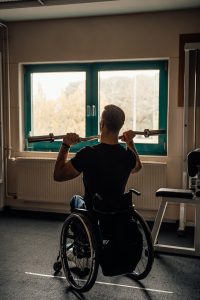 Reduced mobility can be severe, where you’re bedridden, or painful, but not as debilitating, such as a sprained ankle. If you work with a physical therapist, they’ll provide the exercises for the injured area, but you’re responsible for the rest of your body. You can do many exercises to maintain your present fitness level or even improve it. Always check with your healthcare professional before starting or continuing any fitness program.
Reduced mobility can be severe, where you’re bedridden, or painful, but not as debilitating, such as a sprained ankle. If you work with a physical therapist, they’ll provide the exercises for the injured area, but you’re responsible for the rest of your body. You can do many exercises to maintain your present fitness level or even improve it. Always check with your healthcare professional before starting or continuing any fitness program.
If you’re bedridden, move what you can move.
Move your body as much as possible. If you can still move your upper body, move it. Raise your hands above your head and do bed jumping jacks without standing or jumping. It will look like making snow angels in the bed but with a clap at the top of raising your hands. Stretch your muscles. Raise your legs, lifting each leg slightly off the bed, and hold. Bring your knees toward your chest and do a bicycle. Move your muscles until you feel a stretch. It should make you feel better. If it hurts, stop and try a different stretch.
If you’re injured, work the area that’s not.
Work your lower body if your upper body is injured and vice versa. Injuries may include sprains, strains, or broken bones. That usually happens on one side. That means 3/4th of your body is healthy enough to exercise. If you’re chairbound, doing curls and other upper body exercises with small weights or homemade weights like soup cans builds and maintains strength. You can even do reverse push-ups while seated. Place your hands on the seat of your chair and attempt to lift your bottom off the seat.
Move what you can and keep your exercise appropriate for your condition.
Don’t try to overdo it. Don’t push yourself and baby the injured area until it heals. Even then, take it slow. If you’re working with a physical therapist, ask for guidance and check to ensure an exercise won’t exacerbate the injury if you’re unsure. Stretching is excellent, especially if you’re physically limited. It keeps you flexible and helps you feel better by limiting the pain of stiff muscles. Arm circles, overhead lateral reach, cross-body shoulder stretch, and wrist flexors are a few upper-body stretches. Lower body stretches include couch, calf, and half-kneeling hip flexor stretches.
- If you’ve injured an arm or leg, exercise the other side. Studies show it helps maintain muscle strength in the injured and uninjured areas. It boosts circulation to speed healing.
- Get a mobile pull-up bar that’s just above your head when seated. You can pull your body out of your chair, improving upper body strength and providing more mobility.
- Focus on isolation exercises to limit the potential of exacerbating the injury. If you can’t do squats, do leg extensions. You can still train heavy when you choose the right type of exercise.
- Do what you can to keep moving. If you’re in bed, do flutter kicks. If you’re chairbound, lift weights and do single-leg lifts if possible. Isometric exercises are static contractions. They help lower blood pressure and build muscle strength.
For more information, contact us today at Next Level Fitness
